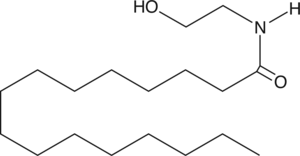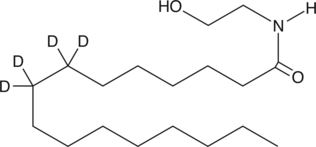Cayman
Showing 33901–34050 of 45550 results
-
Palmitoleic acid-d14 contains 14 deuterium atoms at the 2, 2’, 3, 3’, 4, 4’, 5, 5’, 6, 6’, 7, 7’, 8, and 8’ positions. It is intended for use as an internal standard for the quantification of palmitoleic acid (Item No. 10009871). Palmitoleic acid is an ω-7 monounsaturated fatty acid that is a common constituent of the triglycerides of human adipose tissue. It is found mainly in animal fats, particularly in fish and marine mammals, and is also present in the seeds of plants of the Proteaceae family. In contrast to a diet enriched with oleic acid (Item No. 90260), palmitoleic acid-based diets raise low density lipoprotein (LDL) cholesterol and lower high density lipoprotein (HDL) cholesterol much like that of a saturated fatty acid, even when dietary intake of cholesterol is maintained at a low level.{16300}
Brand:CaymanSKU:9000431 - 1 mgAvailable on backorder
Palmitoleic acid-d14 contains 14 deuterium atoms at the 2, 2’, 3, 3’, 4, 4’, 5, 5’, 6, 6’, 7, 7’, 8, and 8’ positions. It is intended for use as an internal standard for the quantification of palmitoleic acid (Item No. 10009871). Palmitoleic acid is an ω-7 monounsaturated fatty acid that is a common constituent of the triglycerides of human adipose tissue. It is found mainly in animal fats, particularly in fish and marine mammals, and is also present in the seeds of plants of the Proteaceae family. In contrast to a diet enriched with oleic acid (Item No. 90260), palmitoleic acid-based diets raise low density lipoprotein (LDL) cholesterol and lower high density lipoprotein (HDL) cholesterol much like that of a saturated fatty acid, even when dietary intake of cholesterol is maintained at a low level.{16300}
Brand:CaymanSKU:9000431 - 100 µgAvailable on backorder
Palmitoleic acid-d14 contains 14 deuterium atoms at the 2, 2’, 3, 3’, 4, 4’, 5, 5’, 6, 6’, 7, 7’, 8, and 8’ positions. It is intended for use as an internal standard for the quantification of palmitoleic acid (Item No. 10009871). Palmitoleic acid is an ω-7 monounsaturated fatty acid that is a common constituent of the triglycerides of human adipose tissue. It is found mainly in animal fats, particularly in fish and marine mammals, and is also present in the seeds of plants of the Proteaceae family. In contrast to a diet enriched with oleic acid (Item No. 90260), palmitoleic acid-based diets raise low density lipoprotein (LDL) cholesterol and lower high density lipoprotein (HDL) cholesterol much like that of a saturated fatty acid, even when dietary intake of cholesterol is maintained at a low level.{16300}
Brand:CaymanSKU:9000431 - 5 mgAvailable on backorder
Palmitoleic acid-d14 contains 14 deuterium atoms at the 2, 2’, 3, 3’, 4, 4’, 5, 5’, 6, 6’, 7, 7’, 8, and 8’ positions. It is intended for use as an internal standard for the quantification of palmitoleic acid (Item No. 10009871). Palmitoleic acid is an ω-7 monounsaturated fatty acid that is a common constituent of the triglycerides of human adipose tissue. It is found mainly in animal fats, particularly in fish and marine mammals, and is also present in the seeds of plants of the Proteaceae family. In contrast to a diet enriched with oleic acid (Item No. 90260), palmitoleic acid-based diets raise low density lipoprotein (LDL) cholesterol and lower high density lipoprotein (HDL) cholesterol much like that of a saturated fatty acid, even when dietary intake of cholesterol is maintained at a low level.{16300}
Brand:CaymanSKU:9000431 - 500 µgAvailable on backorder
Cyclic phosphatidic acids (cPAs) are naturally occurring analogs of lysophosphatidic acid (LPA) in which the sn-2 hydroxy group forms a 5-membered ring with the sn-3 phosphate.{17448,17449} Carba-derivatives of cPA (ccPA) are modified at the sn-2 (2-ccPA) or sn-3 (3-ccPA) linkage, preventing the opening of cPA to produce lysophosphatidic acid (LPA).{14910} Palmitoleoyl 3-carbacyclic phosphatidic acid (3-ccPA 16:1) is a cyclic LPA analog that contains the 16:1 fatty acid, palmitoleate, at the sn-1 position of the glycerol backbone.{14910} At 25 μM, it inhibits the transcellular migration of MM1 cells across mesothelial cell monolayers in response to fetal bovine serum (86.9%) or LPA (99.9%) without affecting proliferation.{14910} 3-ccPA 16:1 significantly inhibits autotaxin (IC50 = 620 nM),{14911} an enzyme that is important in cancer cell survival, growth, migration, invasion and metastasis. When delivered intraperitoneally, 3-ccPA 16:1 significantly reduces the number of lung metastases formed in mice injected with B16F10 melanoma cells in the tail vein.{14911}
Brand:CaymanSKU:10010298 - 1 mgAvailable on backorder
Cyclic phosphatidic acids (cPAs) are naturally occurring analogs of lysophosphatidic acid (LPA) in which the sn-2 hydroxy group forms a 5-membered ring with the sn-3 phosphate.{17448,17449} Carba-derivatives of cPA (ccPA) are modified at the sn-2 (2-ccPA) or sn-3 (3-ccPA) linkage, preventing the opening of cPA to produce lysophosphatidic acid (LPA).{14910} Palmitoleoyl 3-carbacyclic phosphatidic acid (3-ccPA 16:1) is a cyclic LPA analog that contains the 16:1 fatty acid, palmitoleate, at the sn-1 position of the glycerol backbone.{14910} At 25 μM, it inhibits the transcellular migration of MM1 cells across mesothelial cell monolayers in response to fetal bovine serum (86.9%) or LPA (99.9%) without affecting proliferation.{14910} 3-ccPA 16:1 significantly inhibits autotaxin (IC50 = 620 nM),{14911} an enzyme that is important in cancer cell survival, growth, migration, invasion and metastasis. When delivered intraperitoneally, 3-ccPA 16:1 significantly reduces the number of lung metastases formed in mice injected with B16F10 melanoma cells in the tail vein.{14911}
Brand:CaymanSKU:10010298 - 10 mgAvailable on backorder
Cyclic phosphatidic acids (cPAs) are naturally occurring analogs of lysophosphatidic acid (LPA) in which the sn-2 hydroxy group forms a 5-membered ring with the sn-3 phosphate.{17448,17449} Carba-derivatives of cPA (ccPA) are modified at the sn-2 (2-ccPA) or sn-3 (3-ccPA) linkage, preventing the opening of cPA to produce lysophosphatidic acid (LPA).{14910} Palmitoleoyl 3-carbacyclic phosphatidic acid (3-ccPA 16:1) is a cyclic LPA analog that contains the 16:1 fatty acid, palmitoleate, at the sn-1 position of the glycerol backbone.{14910} At 25 μM, it inhibits the transcellular migration of MM1 cells across mesothelial cell monolayers in response to fetal bovine serum (86.9%) or LPA (99.9%) without affecting proliferation.{14910} 3-ccPA 16:1 significantly inhibits autotaxin (IC50 = 620 nM),{14911} an enzyme that is important in cancer cell survival, growth, migration, invasion and metastasis. When delivered intraperitoneally, 3-ccPA 16:1 significantly reduces the number of lung metastases formed in mice injected with B16F10 melanoma cells in the tail vein.{14911}
Brand:CaymanSKU:10010298 - 5 mgAvailable on backorder
Cyclic phosphatidic acids (cPAs) are naturally occurring analogs of lysophosphatidic acid (LPA) in which the sn-2 hydroxy group forms a 5-membered ring with the sn-3 phosphate.{17448,17449} Carba-derivatives of cPA (ccPA) are modified at the sn-2 (2-ccPA) or sn-3 (3-ccPA) linkage, preventing the opening of cPA to produce lysophosphatidic acid (LPA).{14910} Palmitoleoyl 3-carbacyclic phosphatidic acid (3-ccPA 16:1) is a cyclic LPA analog that contains the 16:1 fatty acid, palmitoleate, at the sn-1 position of the glycerol backbone.{14910} At 25 μM, it inhibits the transcellular migration of MM1 cells across mesothelial cell monolayers in response to fetal bovine serum (86.9%) or LPA (99.9%) without affecting proliferation.{14910} 3-ccPA 16:1 significantly inhibits autotaxin (IC50 = 620 nM),{14911} an enzyme that is important in cancer cell survival, growth, migration, invasion and metastasis. When delivered intraperitoneally, 3-ccPA 16:1 significantly reduces the number of lung metastases formed in mice injected with B16F10 melanoma cells in the tail vein.{14911}
Brand:CaymanSKU:10010298 - 500 µgAvailable on backorder
Palmitoleoyl chloride is a derivative of palmitoleic acid (Item Nos. 10009871 | 21911). It has been used as an intermediate in the synthesis of a variety of compounds, including antiproliferative and anti-inflammatory compounds.{42726,42727}
Brand:CaymanSKU:22723 -Out of stock
Palmitoleoyl chloride is a derivative of palmitoleic acid (Item Nos. 10009871 | 21911). It has been used as an intermediate in the synthesis of a variety of compounds, including antiproliferative and anti-inflammatory compounds.{42726,42727}
Brand:CaymanSKU:22723 -Out of stock
Palmitoleoyl chloride is a derivative of palmitoleic acid (Item Nos. 10009871 | 21911). It has been used as an intermediate in the synthesis of a variety of compounds, including antiproliferative and anti-inflammatory compounds.{42726,42727}
Brand:CaymanSKU:22723 -Out of stock
Palmitoleoyl chloride is a derivative of palmitoleic acid (Item Nos. 10009871 | 21911). It has been used as an intermediate in the synthesis of a variety of compounds, including antiproliferative and anti-inflammatory compounds.{42726,42727}
Brand:CaymanSKU:22723 -Out of stock
N-acylethanolamines (NAEs) are lipid-derived signaling compounds. For example, arachidonoyl ethanolamide is an endogenous cannabinoid (CB) that activates the CB1 and CB2 receptors. Palmitoleoyl Ethanolamide (POEA) is an NAE that is produced endogenously from palmitoleic acid.{19623} Unlike arachidonoyl ethanolamide and palmitoyl ethanolamide, POEA does not have antinociceptive effects, as assessed in the formalin-evoked pain model.{19780}
Brand:CaymanSKU:10965 - 10 mgAvailable on backorder
N-acylethanolamines (NAEs) are lipid-derived signaling compounds. For example, arachidonoyl ethanolamide is an endogenous cannabinoid (CB) that activates the CB1 and CB2 receptors. Palmitoleoyl Ethanolamide (POEA) is an NAE that is produced endogenously from palmitoleic acid.{19623} Unlike arachidonoyl ethanolamide and palmitoyl ethanolamide, POEA does not have antinociceptive effects, as assessed in the formalin-evoked pain model.{19780}
Brand:CaymanSKU:10965 - 100 mgAvailable on backorder
N-acylethanolamines (NAEs) are lipid-derived signaling compounds. For example, arachidonoyl ethanolamide is an endogenous cannabinoid (CB) that activates the CB1 and CB2 receptors. Palmitoleoyl Ethanolamide (POEA) is an NAE that is produced endogenously from palmitoleic acid.{19623} Unlike arachidonoyl ethanolamide and palmitoyl ethanolamide, POEA does not have antinociceptive effects, as assessed in the formalin-evoked pain model.{19780}
Brand:CaymanSKU:10965 - 5 mgAvailable on backorder
N-acylethanolamines (NAEs) are lipid-derived signaling compounds. For example, arachidonoyl ethanolamide is an endogenous cannabinoid (CB) that activates the CB1 and CB2 receptors. Palmitoleoyl Ethanolamide (POEA) is an NAE that is produced endogenously from palmitoleic acid.{19623} Unlike arachidonoyl ethanolamide and palmitoyl ethanolamide, POEA does not have antinociceptive effects, as assessed in the formalin-evoked pain model.{19780}
Brand:CaymanSKU:10965 - 50 mgAvailable on backorder
Cyclic phosphatidic acids (cPAs) are naturally occurring analogs of lysophosphatidic acid (LPA) in which the sn-2 hydroxy group forms a 5-membered ring with the sn-3 phosphate.{17448,17449} Carba-derivatives of cPA (ccPA) are modified at the sn-2 (2-ccPA) or sn-3 (3-ccPA) linkage, preventing the opening of cPA to produce LPA.{14910} Palmitoyl 3-ccPA is a cyclic LPA analog that contains the 16:0 fatty acid, palmitate, at the sn-1 position of the glycerol backbone.{14910} At 25 μM, it inhibits the transcellular migration of MM1 cells across mesothelial cell monolayers in response to fetal bovine serum (81.9%) or LPA (98.9%) without affecting proliferation.{14910} 3-ccPA 16:0, at 0.1-25 μM, significantly inhibits autotaxin,{14911,17450} an enzyme that is important in cancer cell survival, growth, migration, invasion and metastasis.
Brand:CaymanSKU:10010293 - 1 mgAvailable on backorder
Cyclic phosphatidic acids (cPAs) are naturally occurring analogs of lysophosphatidic acid (LPA) in which the sn-2 hydroxy group forms a 5-membered ring with the sn-3 phosphate.{17448,17449} Carba-derivatives of cPA (ccPA) are modified at the sn-2 (2-ccPA) or sn-3 (3-ccPA) linkage, preventing the opening of cPA to produce LPA.{14910} Palmitoyl 3-ccPA is a cyclic LPA analog that contains the 16:0 fatty acid, palmitate, at the sn-1 position of the glycerol backbone.{14910} At 25 μM, it inhibits the transcellular migration of MM1 cells across mesothelial cell monolayers in response to fetal bovine serum (81.9%) or LPA (98.9%) without affecting proliferation.{14910} 3-ccPA 16:0, at 0.1-25 μM, significantly inhibits autotaxin,{14911,17450} an enzyme that is important in cancer cell survival, growth, migration, invasion and metastasis.
Brand:CaymanSKU:10010293 - 10 mgAvailable on backorder
Cyclic phosphatidic acids (cPAs) are naturally occurring analogs of lysophosphatidic acid (LPA) in which the sn-2 hydroxy group forms a 5-membered ring with the sn-3 phosphate.{17448,17449} Carba-derivatives of cPA (ccPA) are modified at the sn-2 (2-ccPA) or sn-3 (3-ccPA) linkage, preventing the opening of cPA to produce LPA.{14910} Palmitoyl 3-ccPA is a cyclic LPA analog that contains the 16:0 fatty acid, palmitate, at the sn-1 position of the glycerol backbone.{14910} At 25 μM, it inhibits the transcellular migration of MM1 cells across mesothelial cell monolayers in response to fetal bovine serum (81.9%) or LPA (98.9%) without affecting proliferation.{14910} 3-ccPA 16:0, at 0.1-25 μM, significantly inhibits autotaxin,{14911,17450} an enzyme that is important in cancer cell survival, growth, migration, invasion and metastasis.
Brand:CaymanSKU:10010293 - 5 mgAvailable on backorder
Cyclic phosphatidic acids (cPAs) are naturally occurring analogs of lysophosphatidic acid (LPA) in which the sn-2 hydroxy group forms a 5-membered ring with the sn-3 phosphate.{17448,17449} Carba-derivatives of cPA (ccPA) are modified at the sn-2 (2-ccPA) or sn-3 (3-ccPA) linkage, preventing the opening of cPA to produce LPA.{14910} Palmitoyl 3-ccPA is a cyclic LPA analog that contains the 16:0 fatty acid, palmitate, at the sn-1 position of the glycerol backbone.{14910} At 25 μM, it inhibits the transcellular migration of MM1 cells across mesothelial cell monolayers in response to fetal bovine serum (81.9%) or LPA (98.9%) without affecting proliferation.{14910} 3-ccPA 16:0, at 0.1-25 μM, significantly inhibits autotaxin,{14911,17450} an enzyme that is important in cancer cell survival, growth, migration, invasion and metastasis.
Brand:CaymanSKU:10010293 - 500 µgAvailable on backorder
Palmitoyl ethanolamide (PEA) is an endogenous cannabinoid found in brain, liver, and other mammalian tissues.{2415} PEA has also been isolated from egg yolk, and found to have anti-anaphylactic and anti-inflammatory activity in vitro.{1633} PEA is an endocannabinoid which has been shown to significantly elevate cAMP in cells expressing CB2 receptors. However, its affinity for CB2 receptors is relatively low, at about 10 µM. CB1 receptors have no appreciable affinity for PEA.{1134}
Brand:CaymanSKU:90350 - 10 mgAvailable on backorder
Palmitoyl ethanolamide (PEA) is an endogenous cannabinoid found in brain, liver, and other mammalian tissues.{2415} PEA has also been isolated from egg yolk, and found to have anti-anaphylactic and anti-inflammatory activity in vitro.{1633} PEA is an endocannabinoid which has been shown to significantly elevate cAMP in cells expressing CB2 receptors. However, its affinity for CB2 receptors is relatively low, at about 10 µM. CB1 receptors have no appreciable affinity for PEA.{1134}
Brand:CaymanSKU:90350 - 100 mgAvailable on backorder
Palmitoyl ethanolamide (PEA) is an endogenous cannabinoid found in brain, liver, and other mammalian tissues.{2415} PEA has also been isolated from egg yolk, and found to have anti-anaphylactic and anti-inflammatory activity in vitro.{1633} PEA is an endocannabinoid which has been shown to significantly elevate cAMP in cells expressing CB2 receptors. However, its affinity for CB2 receptors is relatively low, at about 10 µM. CB1 receptors have no appreciable affinity for PEA.{1134}
Brand:CaymanSKU:90350 - 5 mgAvailable on backorder
Palmitoyl ethanolamide (PEA) is an endogenous cannabinoid found in brain, liver, and other mammalian tissues.{2415} PEA has also been isolated from egg yolk, and found to have anti-anaphylactic and anti-inflammatory activity in vitro.{1633} PEA is an endocannabinoid which has been shown to significantly elevate cAMP in cells expressing CB2 receptors. However, its affinity for CB2 receptors is relatively low, at about 10 µM. CB1 receptors have no appreciable affinity for PEA.{1134}
Brand:CaymanSKU:90350 - 50 mgAvailable on backorder
Palmitoyl ethanolamide-d4 (PEA-d4) contains four deuterium atoms at the 7, 7′, 8, and 8′ positions. It is intended for use as an internal standard for the quantification of PEA by GC- or LC-mass spectrometry. PEA is an endogenous cannabinoid found in brain, liver, and other mammalian tissues.{2415} PEA has also been isolated from egg yolk, and found to have anti-anaphylactic and anti-inflammatory activity in vitro.{1633} PEA is an endocannabinoid which has been shown to significantly elevate cyclic AMP in cells expressing peripheral cannabinoid (CB2) receptors. However, its affinity for CB2 receptors is relatively low, at about 10 µM. Central cannabinoid (CB1) receptors have no appreciable affinity for PEA.{1134}
Brand:CaymanSKU:10007824 - 1 mgAvailable on backorder
Palmitoyl ethanolamide-d4 (PEA-d4) contains four deuterium atoms at the 1,1′, 2, and 2′ positions. It is intended for use as an internal standard for the quantification of PEA by GC- or LC-mass spectrometry. Palmitoyl ethanolamide (PEA) is an endogenous cannabinoid found in brain, liver, and other mammalian tissues.{2415} PEA has also been isolated from egg yolk, and found to have anti-anaphylactic and anti-inflammatory activity in vitro.{1633} PEA is an endocannabinoid which has been shown to significantly elevate cAMP in cells expressing CB2 receptors. However, its affinity for CB2 receptors is relatively low, at about 10 µM. CB1 receptors have no appreciable affinity for PEA.{1134}
Brand:CaymanSKU:9000551 - 1 mgAvailable on backorder
Palmitoyl ethanolamide-d4 (PEA-d4) contains four deuterium atoms at the 7, 7′, 8, and 8′ positions. It is intended for use as an internal standard for the quantification of PEA by GC- or LC-mass spectrometry. PEA is an endogenous cannabinoid found in brain, liver, and other mammalian tissues.{2415} PEA has also been isolated from egg yolk, and found to have anti-anaphylactic and anti-inflammatory activity in vitro.{1633} PEA is an endocannabinoid which has been shown to significantly elevate cyclic AMP in cells expressing peripheral cannabinoid (CB2) receptors. However, its affinity for CB2 receptors is relatively low, at about 10 µM. Central cannabinoid (CB1) receptors have no appreciable affinity for PEA.{1134}
Brand:CaymanSKU:10007824 - 100 µgAvailable on backorder
Palmitoyl ethanolamide-d4 (PEA-d4) contains four deuterium atoms at the 1,1′, 2, and 2′ positions. It is intended for use as an internal standard for the quantification of PEA by GC- or LC-mass spectrometry. Palmitoyl ethanolamide (PEA) is an endogenous cannabinoid found in brain, liver, and other mammalian tissues.{2415} PEA has also been isolated from egg yolk, and found to have anti-anaphylactic and anti-inflammatory activity in vitro.{1633} PEA is an endocannabinoid which has been shown to significantly elevate cAMP in cells expressing CB2 receptors. However, its affinity for CB2 receptors is relatively low, at about 10 µM. CB1 receptors have no appreciable affinity for PEA.{1134}
Brand:CaymanSKU:9000551 - 100 µgAvailable on backorder
Palmitoyl ethanolamide-d4 (PEA-d4) contains four deuterium atoms at the 7, 7′, 8, and 8′ positions. It is intended for use as an internal standard for the quantification of PEA by GC- or LC-mass spectrometry. PEA is an endogenous cannabinoid found in brain, liver, and other mammalian tissues.{2415} PEA has also been isolated from egg yolk, and found to have anti-anaphylactic and anti-inflammatory activity in vitro.{1633} PEA is an endocannabinoid which has been shown to significantly elevate cyclic AMP in cells expressing peripheral cannabinoid (CB2) receptors. However, its affinity for CB2 receptors is relatively low, at about 10 µM. Central cannabinoid (CB1) receptors have no appreciable affinity for PEA.{1134}
Brand:CaymanSKU:10007824 - 5 mgAvailable on backorder
Palmitoyl ethanolamide-d4 (PEA-d4) contains four deuterium atoms at the 1,1′, 2, and 2′ positions. It is intended for use as an internal standard for the quantification of PEA by GC- or LC-mass spectrometry. Palmitoyl ethanolamide (PEA) is an endogenous cannabinoid found in brain, liver, and other mammalian tissues.{2415} PEA has also been isolated from egg yolk, and found to have anti-anaphylactic and anti-inflammatory activity in vitro.{1633} PEA is an endocannabinoid which has been shown to significantly elevate cAMP in cells expressing CB2 receptors. However, its affinity for CB2 receptors is relatively low, at about 10 µM. CB1 receptors have no appreciable affinity for PEA.{1134}
Brand:CaymanSKU:9000551 - 5 mgAvailable on backorder
Palmitoyl ethanolamide-d4 (PEA-d4) contains four deuterium atoms at the 7, 7′, 8, and 8′ positions. It is intended for use as an internal standard for the quantification of PEA by GC- or LC-mass spectrometry. PEA is an endogenous cannabinoid found in brain, liver, and other mammalian tissues.{2415} PEA has also been isolated from egg yolk, and found to have anti-anaphylactic and anti-inflammatory activity in vitro.{1633} PEA is an endocannabinoid which has been shown to significantly elevate cyclic AMP in cells expressing peripheral cannabinoid (CB2) receptors. However, its affinity for CB2 receptors is relatively low, at about 10 µM. Central cannabinoid (CB1) receptors have no appreciable affinity for PEA.{1134}
Brand:CaymanSKU:10007824 - 500 µgAvailable on backorder
Palmitoyl ethanolamide-d4 (PEA-d4) contains four deuterium atoms at the 1,1′, 2, and 2′ positions. It is intended for use as an internal standard for the quantification of PEA by GC- or LC-mass spectrometry. Palmitoyl ethanolamide (PEA) is an endogenous cannabinoid found in brain, liver, and other mammalian tissues.{2415} PEA has also been isolated from egg yolk, and found to have anti-anaphylactic and anti-inflammatory activity in vitro.{1633} PEA is an endocannabinoid which has been shown to significantly elevate cAMP in cells expressing CB2 receptors. However, its affinity for CB2 receptors is relatively low, at about 10 µM. CB1 receptors have no appreciable affinity for PEA.{1134}
Brand:CaymanSKU:9000551 - 500 µgAvailable on backorder
PIA is a synthetic analog of palmitoyl ethanolamide which incorporates isopropyl amide in place of the native ethanolamide. PIA does not bind appreciably to either CB1 or CB2 receptors.{9113} PIA inhibits both the transport (re-uptake) of tritiated AEA into intact cells, as well as the subsequent hydrolysis of AEA to arachidonate and ethanolamine, with 50% inhibition of FAAH-mediated hydrolysis at 10 µM.{9113}
Brand:CaymanSKU:91354 - 10 mgAvailable on backorder
PIA is a synthetic analog of palmitoyl ethanolamide which incorporates isopropyl amide in place of the native ethanolamide. PIA does not bind appreciably to either CB1 or CB2 receptors.{9113} PIA inhibits both the transport (re-uptake) of tritiated AEA into intact cells, as well as the subsequent hydrolysis of AEA to arachidonate and ethanolamine, with 50% inhibition of FAAH-mediated hydrolysis at 10 µM.{9113}
Brand:CaymanSKU:91354 - 100 mgAvailable on backorder
PIA is a synthetic analog of palmitoyl ethanolamide which incorporates isopropyl amide in place of the native ethanolamide. PIA does not bind appreciably to either CB1 or CB2 receptors.{9113} PIA inhibits both the transport (re-uptake) of tritiated AEA into intact cells, as well as the subsequent hydrolysis of AEA to arachidonate and ethanolamine, with 50% inhibition of FAAH-mediated hydrolysis at 10 µM.{9113}
Brand:CaymanSKU:91354 - 5 mgAvailable on backorder
PIA is a synthetic analog of palmitoyl ethanolamide which incorporates isopropyl amide in place of the native ethanolamide. PIA does not bind appreciably to either CB1 or CB2 receptors.{9113} PIA inhibits both the transport (re-uptake) of tritiated AEA into intact cells, as well as the subsequent hydrolysis of AEA to arachidonate and ethanolamine, with 50% inhibition of FAAH-mediated hydrolysis at 10 µM.{9113}
Brand:CaymanSKU:91354 - 50 mgAvailable on backorder
2-Palmitoyl glycerol (2-PG) has been isolated along with the potent endocannabinoid 2-arachidonoyl glycerol (2-AG) from various tissues.{9610} Although 2-PG displays no intrinsic agonist activity on CB1 or CB2 receptors, it does potentiate the ability of 2-AG to inhibit adenylyl cyclase. 2-PG also potentiates the analgesic, hypokinetic, and anxiolytic effects of 2-AG in mice. This “entourage” effect has been attributed to the ability of compounds such as 2-PG to inhibit reuptake and/or compete with the active endocannabinoids for access to inactivating enzymes such as FAAH and monoglyceride lipase.{10671,9575} Palmitoyl serinol is a stable analog of 2-PG bearing an amide linkage in place of the labile glyceryl ester. This has the potential to enhance its “entourage” activities as a result of a prolonged in vivo half-life. Palmitoyl serinol is also an analog of C-16 ceramide. Incubation of neuroblastoma cells with palmitoyl serinol causes apoptosis with an IC50 of approximately 80 µM.{8954,10417}
Brand:CaymanSKU:62175 - 10 mgAvailable on backorder
2-Palmitoyl glycerol (2-PG) has been isolated along with the potent endocannabinoid 2-arachidonoyl glycerol (2-AG) from various tissues.{9610} Although 2-PG displays no intrinsic agonist activity on CB1 or CB2 receptors, it does potentiate the ability of 2-AG to inhibit adenylyl cyclase. 2-PG also potentiates the analgesic, hypokinetic, and anxiolytic effects of 2-AG in mice. This “entourage” effect has been attributed to the ability of compounds such as 2-PG to inhibit reuptake and/or compete with the active endocannabinoids for access to inactivating enzymes such as FAAH and monoglyceride lipase.{10671,9575} Palmitoyl serinol is a stable analog of 2-PG bearing an amide linkage in place of the labile glyceryl ester. This has the potential to enhance its “entourage” activities as a result of a prolonged in vivo half-life. Palmitoyl serinol is also an analog of C-16 ceramide. Incubation of neuroblastoma cells with palmitoyl serinol causes apoptosis with an IC50 of approximately 80 µM.{8954,10417}
Brand:CaymanSKU:62175 - 100 mgAvailable on backorder
2-Palmitoyl glycerol (2-PG) has been isolated along with the potent endocannabinoid 2-arachidonoyl glycerol (2-AG) from various tissues.{9610} Although 2-PG displays no intrinsic agonist activity on CB1 or CB2 receptors, it does potentiate the ability of 2-AG to inhibit adenylyl cyclase. 2-PG also potentiates the analgesic, hypokinetic, and anxiolytic effects of 2-AG in mice. This “entourage” effect has been attributed to the ability of compounds such as 2-PG to inhibit reuptake and/or compete with the active endocannabinoids for access to inactivating enzymes such as FAAH and monoglyceride lipase.{10671,9575} Palmitoyl serinol is a stable analog of 2-PG bearing an amide linkage in place of the labile glyceryl ester. This has the potential to enhance its “entourage” activities as a result of a prolonged in vivo half-life. Palmitoyl serinol is also an analog of C-16 ceramide. Incubation of neuroblastoma cells with palmitoyl serinol causes apoptosis with an IC50 of approximately 80 µM.{8954,10417}
Brand:CaymanSKU:62175 - 5 mgAvailable on backorder
2-Palmitoyl glycerol (2-PG) has been isolated along with the potent endocannabinoid 2-arachidonoyl glycerol (2-AG) from various tissues.{9610} Although 2-PG displays no intrinsic agonist activity on CB1 or CB2 receptors, it does potentiate the ability of 2-AG to inhibit adenylyl cyclase. 2-PG also potentiates the analgesic, hypokinetic, and anxiolytic effects of 2-AG in mice. This “entourage” effect has been attributed to the ability of compounds such as 2-PG to inhibit reuptake and/or compete with the active endocannabinoids for access to inactivating enzymes such as FAAH and monoglyceride lipase.{10671,9575} Palmitoyl serinol is a stable analog of 2-PG bearing an amide linkage in place of the labile glyceryl ester. This has the potential to enhance its “entourage” activities as a result of a prolonged in vivo half-life. Palmitoyl serinol is also an analog of C-16 ceramide. Incubation of neuroblastoma cells with palmitoyl serinol causes apoptosis with an IC50 of approximately 80 µM.{8954,10417}
Brand:CaymanSKU:62175 - 50 mgAvailable on backorder
Palmitoyl serotonin is a hybrid molecule patterned after arachidonoyl serotonin (Catalog No. 70665). Arachidonoyl serotonin is a dual antagonist of fatty acid amide hydrolase (FAAH) and the transient receptor potential vanilloid-type 1 (TRPV1) channel, reducing both acute and chronic peripheral pain.{18121,18122} The effects of replacing the arachidonoyl portion with the saturated 16-carbon palmitoyl moiety have not been studied. However, replacement of arachidonate with saturated 11- or 12-carbon fatty acids produces compounds that potently inhibit capsaicin-induced TRPV1 channel activation (IC50 = 0.76 μM) without blocking FAAH-mediated hydrolysis of arachidonoyl ethanolamine (IC50 > 50 μM).{18121}
Brand:CaymanSKU:9000630 - 1 mgAvailable on backorder
Palmitoyl serotonin is a hybrid molecule patterned after arachidonoyl serotonin (Catalog No. 70665). Arachidonoyl serotonin is a dual antagonist of fatty acid amide hydrolase (FAAH) and the transient receptor potential vanilloid-type 1 (TRPV1) channel, reducing both acute and chronic peripheral pain.{18121,18122} The effects of replacing the arachidonoyl portion with the saturated 16-carbon palmitoyl moiety have not been studied. However, replacement of arachidonate with saturated 11- or 12-carbon fatty acids produces compounds that potently inhibit capsaicin-induced TRPV1 channel activation (IC50 = 0.76 μM) without blocking FAAH-mediated hydrolysis of arachidonoyl ethanolamine (IC50 > 50 μM).{18121}
Brand:CaymanSKU:9000630 - 10 mgAvailable on backorder
Palmitoyl serotonin is a hybrid molecule patterned after arachidonoyl serotonin (Catalog No. 70665). Arachidonoyl serotonin is a dual antagonist of fatty acid amide hydrolase (FAAH) and the transient receptor potential vanilloid-type 1 (TRPV1) channel, reducing both acute and chronic peripheral pain.{18121,18122} The effects of replacing the arachidonoyl portion with the saturated 16-carbon palmitoyl moiety have not been studied. However, replacement of arachidonate with saturated 11- or 12-carbon fatty acids produces compounds that potently inhibit capsaicin-induced TRPV1 channel activation (IC50 = 0.76 μM) without blocking FAAH-mediated hydrolysis of arachidonoyl ethanolamine (IC50 > 50 μM).{18121}
Brand:CaymanSKU:9000630 - 25 mgAvailable on backorder
Palmitoyl serotonin is a hybrid molecule patterned after arachidonoyl serotonin (Catalog No. 70665). Arachidonoyl serotonin is a dual antagonist of fatty acid amide hydrolase (FAAH) and the transient receptor potential vanilloid-type 1 (TRPV1) channel, reducing both acute and chronic peripheral pain.{18121,18122} The effects of replacing the arachidonoyl portion with the saturated 16-carbon palmitoyl moiety have not been studied. However, replacement of arachidonate with saturated 11- or 12-carbon fatty acids produces compounds that potently inhibit capsaicin-induced TRPV1 channel activation (IC50 = 0.76 μM) without blocking FAAH-mediated hydrolysis of arachidonoyl ethanolamine (IC50 > 50 μM).{18121}
Brand:CaymanSKU:9000630 - 5 mgAvailable on backorder
Thioester analogs of glycerophospholipids, in combination with Ellman’s reagent, are convenient colorimetric substrates for the measurement of phospholipase (PL) activity.{1358,1359} Palmitoyl thio-PC is a chromogenic PLA2 substrate that contains a palmitoyl thioester at the sn-2 position of the glycerol backbone. Hydrolysis of the thioester by PLA2 yields a free thiol that reacts readily with DTNB (Ellman’s reagent) giving a bright yellow product with an absorbance maximum at 412 nm. Palmitoyl thio-PC has been used to measure bee venom sPLA2 activity in a phospholipid:Triton X-100 mixed micelle system.{15581}
Brand:CaymanSKU:10010521 - 1 mgAvailable on backorder
Thioester analogs of glycerophospholipids, in combination with Ellman’s reagent, are convenient colorimetric substrates for the measurement of phospholipase (PL) activity.{1358,1359} Palmitoyl thio-PC is a chromogenic PLA2 substrate that contains a palmitoyl thioester at the sn-2 position of the glycerol backbone. Hydrolysis of the thioester by PLA2 yields a free thiol that reacts readily with DTNB (Ellman’s reagent) giving a bright yellow product with an absorbance maximum at 412 nm. Palmitoyl thio-PC has been used to measure bee venom sPLA2 activity in a phospholipid:Triton X-100 mixed micelle system.{15581}
Brand:CaymanSKU:10010521 - 10 mgAvailable on backorder
Thioester analogs of glycerophospholipids, in combination with Ellman’s reagent, are convenient colorimetric substrates for the measurement of phospholipase (PL) activity.{1358,1359} Palmitoyl thio-PC is a chromogenic PLA2 substrate that contains a palmitoyl thioester at the sn-2 position of the glycerol backbone. Hydrolysis of the thioester by PLA2 yields a free thiol that reacts readily with DTNB (Ellman’s reagent) giving a bright yellow product with an absorbance maximum at 412 nm. Palmitoyl thio-PC has been used to measure bee venom sPLA2 activity in a phospholipid:Triton X-100 mixed micelle system.{15581}
Brand:CaymanSKU:10010521 - 5 mgAvailable on backorder
Brand:CaymanSKU:27565 - 1 gAvailable on backorder
Brand:CaymanSKU:27565 - 100 mgAvailable on backorder
Brand:CaymanSKU:27565 - 250 mgAvailable on backorder
Brand:CaymanSKU:27565 - 500 mgAvailable on backorder
Palmitoyl-D-carnitine is a long-chain acylcarnitine, an isomer of palmitoyl-L-carnitine (Item No. 26553), and the D enantiomer of palmitoyl-DL-carnitine (Item No. 11095).{48106} It inhibits carnitine palmitoyltransferase with a Ki value of 2.1 mM for 14C-palmitoylcarnitine synthesis by erythrocyte membranes.
Brand:CaymanSKU:26552 - 1 mgAvailable on backorder
Palmitoyl-D-carnitine is a long-chain acylcarnitine, an isomer of palmitoyl-L-carnitine (Item No. 26553), and the D enantiomer of palmitoyl-DL-carnitine (Item No. 11095).{48106} It inhibits carnitine palmitoyltransferase with a Ki value of 2.1 mM for 14C-palmitoylcarnitine synthesis by erythrocyte membranes.
Brand:CaymanSKU:26552 - 10 mgAvailable on backorder
Palmitoyl-D-carnitine is a long-chain acylcarnitine, an isomer of palmitoyl-L-carnitine (Item No. 26553), and the D enantiomer of palmitoyl-DL-carnitine (Item No. 11095).{48106} It inhibits carnitine palmitoyltransferase with a Ki value of 2.1 mM for 14C-palmitoylcarnitine synthesis by erythrocyte membranes.
Brand:CaymanSKU:26552 - 5 mgAvailable on backorder
Palmitoyl-DL-carnitine is a long-chain acylcarnitine with both intracellular and extracellular roles. Within the cell, palmitoylcarnitine is transported into mitochondria to deliver palmitate for fatty acid oxidation and energy production.{20215} Exogenously added Palmitoyl-DL-carnitine alters calcium mobilization in many cell types.{20218,20222,20221} It also affects endothelial and epithelial tight junctions, reducing resistance and increasing permeability while decreasing cell viability.{20217,20220}
Brand:CaymanSKU:11095 - 100 mgAvailable on backorder
Palmitoyl-DL-carnitine is a long-chain acylcarnitine with both intracellular and extracellular roles. Within the cell, palmitoylcarnitine is transported into mitochondria to deliver palmitate for fatty acid oxidation and energy production.{20215} Exogenously added Palmitoyl-DL-carnitine alters calcium mobilization in many cell types.{20218,20222,20221} It also affects endothelial and epithelial tight junctions, reducing resistance and increasing permeability while decreasing cell viability.{20217,20220}
Brand:CaymanSKU:11095 - 50 mgAvailable on backorder
Palmitoyl-DL-carnitine is a long-chain acylcarnitine with both intracellular and extracellular roles. Within the cell, palmitoylcarnitine is transported into mitochondria to deliver palmitate for fatty acid oxidation and energy production.{20215} Exogenously added Palmitoyl-DL-carnitine alters calcium mobilization in many cell types.{20218,20222,20221} It also affects endothelial and epithelial tight junctions, reducing resistance and increasing permeability while decreasing cell viability.{20217,20220}
Brand:CaymanSKU:11095 - 500 mgAvailable on backorder
Palmitoyl-L-carnitine is a naturally occurring long-chain acylcarnitine and the L-enantiomer of palmitoyl-DL-carnitine (Item No. 11095).{20215} In cells, palmitoyl-L-carnitine is transported into mitochondria via carnitine palmitoyl transferase II to deliver palmitate for fatty acid oxidation and energy production.{20218} It also inhibits lecithin:cholesterol acyltransferase activity in rat, but not human, plasma when used at a concentration of 500 µM.{42574} In vivo, palmitoyl-L-carnitine increases intestinal absorption of the antibiotic cefoxitin (Item No. 15990) in rat intestine.{46086}
Brand:CaymanSKU:26553 - 10 mgAvailable on backorder
Palmitoyl-L-carnitine is a naturally occurring long-chain acylcarnitine and the L-enantiomer of palmitoyl-DL-carnitine (Item No. 11095).{20215} In cells, palmitoyl-L-carnitine is transported into mitochondria via carnitine palmitoyl transferase II to deliver palmitate for fatty acid oxidation and energy production.{20218} It also inhibits lecithin:cholesterol acyltransferase activity in rat, but not human, plasma when used at a concentration of 500 µM.{42574} In vivo, palmitoyl-L-carnitine increases intestinal absorption of the antibiotic cefoxitin (Item No. 15990) in rat intestine.{46086}
Brand:CaymanSKU:26553 - 25 mgAvailable on backorder
Palmitoyl-L-carnitine is a naturally occurring long-chain acylcarnitine and the L-enantiomer of palmitoyl-DL-carnitine (Item No. 11095).{20215} In cells, palmitoyl-L-carnitine is transported into mitochondria via carnitine palmitoyl transferase II to deliver palmitate for fatty acid oxidation and energy production.{20218} It also inhibits lecithin:cholesterol acyltransferase activity in rat, but not human, plasma when used at a concentration of 500 µM.{42574} In vivo, palmitoyl-L-carnitine increases intestinal absorption of the antibiotic cefoxitin (Item No. 15990) in rat intestine.{46086}
Brand:CaymanSKU:26553 - 5 mgAvailable on backorder
Palmitoyl-L-carnitine is a naturally occurring long-chain acylcarnitine and the L-enantiomer of palmitoyl-DL-carnitine (Item No. 11095).{20215} In cells, palmitoyl-L-carnitine is transported into mitochondria via carnitine palmitoyl transferase II to deliver palmitate for fatty acid oxidation and energy production.{20218} It also inhibits lecithin:cholesterol acyltransferase activity in rat, but not human, plasma when used at a concentration of 500 µM.{42574} In vivo, palmitoyl-L-carnitine increases intestinal absorption of the antibiotic cefoxitin (Item No. 15990) in rat intestine.{46086}
Brand:CaymanSKU:26553 - 50 mgAvailable on backorder
Palmitoyl-L-carnitine-d3 is intended for use as an internal standard for the quantification of palmitoyl-L-carnitine (Item No. 26553) by GC- or LC-MS. Palmitoyl-L-carnitine is a naturally occurring long-chain acylcarnitine and the L-enantiomer of palmitoyl-DL-carnitine (Item No. 11095).{20215} In cells, palmitoyl-L-carnitine is transported into mitochondria via carnitine palmitoyl transferase II to deliver palmitate for fatty acid oxidation and energy production.{20218} It also inhibits lecithin:cholesterol acyltransferase activity in rat, but not human, plasma when used at a concentration of 500 µM.{42574} In vivo, palmitoyl-L-carnitine increases intestinal absorption of the antibiotic cefoxitin (Item No. 15990) in rat intestine.{46086}
Brand:CaymanSKU:26569 - 1 mgAvailable on backorder
Palmitoyl-L-carnitine-d3 is intended for use as an internal standard for the quantification of palmitoyl-L-carnitine (Item No. 26553) by GC- or LC-MS. Palmitoyl-L-carnitine is a naturally occurring long-chain acylcarnitine and the L-enantiomer of palmitoyl-DL-carnitine (Item No. 11095).{20215} In cells, palmitoyl-L-carnitine is transported into mitochondria via carnitine palmitoyl transferase II to deliver palmitate for fatty acid oxidation and energy production.{20218} It also inhibits lecithin:cholesterol acyltransferase activity in rat, but not human, plasma when used at a concentration of 500 µM.{42574} In vivo, palmitoyl-L-carnitine increases intestinal absorption of the antibiotic cefoxitin (Item No. 15990) in rat intestine.{46086}
Brand:CaymanSKU:26569 - 5 mgAvailable on backorder
Palmitoyl-L-carnitine-d3 is intended for use as an internal standard for the quantification of palmitoyl-L-carnitine (Item No. 26553) by GC- or LC-MS. Palmitoyl-L-carnitine is a naturally occurring long-chain acylcarnitine and the L-enantiomer of palmitoyl-DL-carnitine (Item No. 11095).{20215} In cells, palmitoyl-L-carnitine is transported into mitochondria via carnitine palmitoyl transferase II to deliver palmitate for fatty acid oxidation and energy production.{20218} It also inhibits lecithin:cholesterol acyltransferase activity in rat, but not human, plasma when used at a concentration of 500 µM.{42574} In vivo, palmitoyl-L-carnitine increases intestinal absorption of the antibiotic cefoxitin (Item No. 15990) in rat intestine.{46086}
Brand:CaymanSKU:26569 - 500 µgAvailable on backorder
Palmitoylcholine is an acyl choline.{54245} It inhibits protein kinase C activity when used at a concentration of 100 μM.{54246} Palmitoylcholine induces hemolysis in rat erythrocytes.{54244} Plasma levels of palmitoylcholine are decreased in female patients with myalgic encephalomyelitis/chronic fatigue syndrome (ME/CFS).{54245}
Brand:CaymanSKU:9003456 - 10 mgAvailable on backorder
Palmitoylcholine is an acyl choline.{54245} It inhibits protein kinase C activity when used at a concentration of 100 μM.{54246} Palmitoylcholine induces hemolysis in rat erythrocytes.{54244} Plasma levels of palmitoylcholine are decreased in female patients with myalgic encephalomyelitis/chronic fatigue syndrome (ME/CFS).{54245}
Brand:CaymanSKU:9003456 - 25 mgAvailable on backorder
Palmitoylcholine is an acyl choline.{54245} It inhibits protein kinase C activity when used at a concentration of 100 μM.{54246} Palmitoylcholine induces hemolysis in rat erythrocytes.{54244} Plasma levels of palmitoylcholine are decreased in female patients with myalgic encephalomyelitis/chronic fatigue syndrome (ME/CFS).{54245}
Brand:CaymanSKU:9003456 - 5 mgAvailable on backorder
PTK is an analog of palmitic acid in which the COOH group is replaced by trifluoromethyl ketone. In P388D1 cells, PTK inhibits iPLA2 activity with an IC50 value of 3.8 µM.{1291} A related compound, ATK is a less potent inhibitor of iPLA2 with an IC50 value of 15 µM.{1291} PTK also inhibits the activity of cPLA2 with an IC50 value almost identical to that of ATK.{2992}
Brand:CaymanSKU:62650 - 1 mgAvailable on backorder
PTK is an analog of palmitic acid in which the COOH group is replaced by trifluoromethyl ketone. In P388D1 cells, PTK inhibits iPLA2 activity with an IC50 value of 3.8 µM.{1291} A related compound, ATK is a less potent inhibitor of iPLA2 with an IC50 value of 15 µM.{1291} PTK also inhibits the activity of cPLA2 with an IC50 value almost identical to that of ATK.{2992}
Brand:CaymanSKU:62650 - 10 mgAvailable on backorder
PTK is an analog of palmitic acid in which the COOH group is replaced by trifluoromethyl ketone. In P388D1 cells, PTK inhibits iPLA2 activity with an IC50 value of 3.8 µM.{1291} A related compound, ATK is a less potent inhibitor of iPLA2 with an IC50 value of 15 µM.{1291} PTK also inhibits the activity of cPLA2 with an IC50 value almost identical to that of ATK.{2992}
Brand:CaymanSKU:62650 - 25 mgAvailable on backorder
PTK is an analog of palmitic acid in which the COOH group is replaced by trifluoromethyl ketone. In P388D1 cells, PTK inhibits iPLA2 activity with an IC50 value of 3.8 µM.{1291} A related compound, ATK is a less potent inhibitor of iPLA2 with an IC50 value of 15 µM.{1291} PTK also inhibits the activity of cPLA2 with an IC50 value almost identical to that of ATK.{2992}
Brand:CaymanSKU:62650 - 5 mgAvailable on backorder
Palomid 529 (P529) is an inhibitor of mammalian target of rapamycin complex (mTORC) formation.{39092} It is a derivative of a non-steroidal estrogen antagonist that has anti-angiogenic and anticancer activity but lacks estrogen receptor binding activity in estrogen binding assays in vitro. Palomid 529 inhibits VEGF-driven and bFGF-driven endothelial cell proliferation (IC50s = 20 and 30 nM, respectively) and reduces VEGF-A-driven phosphorylation of AktS473, an mTORC2 substrate. In vivo, palomid 529 inhibits retinal neovascularization in mice with oxygen-induced retinopathy, a commonly used assay for pathogenic angiogenesis, Ad-VEGF-A-driven angiogenesis, and phosphorylation of AktS473. Palomid 529 has anticancer effects in glioma cancer cells and xenografts via AktS473 signaling downtstream of mTORC.
Brand:CaymanSKU:22706 -Out of stock
Palomid 529 (P529) is an inhibitor of mammalian target of rapamycin complex (mTORC) formation.{39092} It is a derivative of a non-steroidal estrogen antagonist that has anti-angiogenic and anticancer activity but lacks estrogen receptor binding activity in estrogen binding assays in vitro. Palomid 529 inhibits VEGF-driven and bFGF-driven endothelial cell proliferation (IC50s = 20 and 30 nM, respectively) and reduces VEGF-A-driven phosphorylation of AktS473, an mTORC2 substrate. In vivo, palomid 529 inhibits retinal neovascularization in mice with oxygen-induced retinopathy, a commonly used assay for pathogenic angiogenesis, Ad-VEGF-A-driven angiogenesis, and phosphorylation of AktS473. Palomid 529 has anticancer effects in glioma cancer cells and xenografts via AktS473 signaling downtstream of mTORC.
Brand:CaymanSKU:22706 -Out of stock
Palomid 529 (P529) is an inhibitor of mammalian target of rapamycin complex (mTORC) formation.{39092} It is a derivative of a non-steroidal estrogen antagonist that has anti-angiogenic and anticancer activity but lacks estrogen receptor binding activity in estrogen binding assays in vitro. Palomid 529 inhibits VEGF-driven and bFGF-driven endothelial cell proliferation (IC50s = 20 and 30 nM, respectively) and reduces VEGF-A-driven phosphorylation of AktS473, an mTORC2 substrate. In vivo, palomid 529 inhibits retinal neovascularization in mice with oxygen-induced retinopathy, a commonly used assay for pathogenic angiogenesis, Ad-VEGF-A-driven angiogenesis, and phosphorylation of AktS473. Palomid 529 has anticancer effects in glioma cancer cells and xenografts via AktS473 signaling downtstream of mTORC.
Brand:CaymanSKU:22706 -Out of stock
Palomid 529 (P529) is an inhibitor of mammalian target of rapamycin complex (mTORC) formation.{39092} It is a derivative of a non-steroidal estrogen antagonist that has anti-angiogenic and anticancer activity but lacks estrogen receptor binding activity in estrogen binding assays in vitro. Palomid 529 inhibits VEGF-driven and bFGF-driven endothelial cell proliferation (IC50s = 20 and 30 nM, respectively) and reduces VEGF-A-driven phosphorylation of AktS473, an mTORC2 substrate. In vivo, palomid 529 inhibits retinal neovascularization in mice with oxygen-induced retinopathy, a commonly used assay for pathogenic angiogenesis, Ad-VEGF-A-driven angiogenesis, and phosphorylation of AktS473. Palomid 529 has anticancer effects in glioma cancer cells and xenografts via AktS473 signaling downtstream of mTORC.
Brand:CaymanSKU:22706 -Out of stock
Palonosetron is an antagonist of the serotonin (5-HT) receptor subtype 5-HT3 (Ki = 0.04 nM).{27432} It is selective for 5-HT3 over 5-HT1A, 5-HT1D, 5-HT2A, and 5-HT2C receptors (Kis = ≥15.85 μM for all), as well as a panel of additional neurotransmitter receptors. Palonosetron inhibits 5-HT-induced contraction in isolated guinea pig ileum. It inhibits cisplatin-induced emesis in ferrets (ID50 = 1.1 μg/kg, i.v.) as well as emesis induced by cisplatin (Item No. 13119), dacarbazine (Item No. 21877), actinomycin D (Item No. 11421), and mechlorethamine in dogs (ID50s = 1.9, 4.1, 4.9, and 4.4 μg/kg, respectively).{27431} Formulations containing palonosetron have been used in the treatment of postoperative or chemotherapy-induced nausea and vomiting.
Brand:CaymanSKU:-Out of stock
Palonosetron is an antagonist of the serotonin (5-HT) receptor subtype 5-HT3 (Ki = 0.04 nM).{27432} It is selective for 5-HT3 over 5-HT1A, 5-HT1D, 5-HT2A, and 5-HT2C receptors (Kis = ≥15.85 μM for all), as well as a panel of additional neurotransmitter receptors. Palonosetron inhibits 5-HT-induced contraction in isolated guinea pig ileum. It inhibits cisplatin-induced emesis in ferrets (ID50 = 1.1 μg/kg, i.v.) as well as emesis induced by cisplatin (Item No. 13119), dacarbazine (Item No. 21877), actinomycin D (Item No. 11421), and mechlorethamine in dogs (ID50s = 1.9, 4.1, 4.9, and 4.4 μg/kg, respectively).{27431} Formulations containing palonosetron have been used in the treatment of postoperative or chemotherapy-induced nausea and vomiting.
Brand:CaymanSKU:-Out of stock
Palonosetron is an antagonist of the serotonin (5-HT) receptor subtype 5-HT3 (Ki = 0.04 nM).{27432} It is selective for 5-HT3 over 5-HT1A, 5-HT1D, 5-HT2A, and 5-HT2C receptors (Kis = ≥15.85 μM for all), as well as a panel of additional neurotransmitter receptors. Palonosetron inhibits 5-HT-induced contraction in isolated guinea pig ileum. It inhibits cisplatin-induced emesis in ferrets (ID50 = 1.1 μg/kg, i.v.) as well as emesis induced by cisplatin (Item No. 13119), dacarbazine (Item No. 21877), actinomycin D (Item No. 11421), and mechlorethamine in dogs (ID50s = 1.9, 4.1, 4.9, and 4.4 μg/kg, respectively).{27431} Formulations containing palonosetron have been used in the treatment of postoperative or chemotherapy-induced nausea and vomiting.
Brand:CaymanSKU:-Out of stock
Palosuran is an antagonist of the urotensin II receptor (UTR; IC50s = 3.6 and 1,475 nM for CHO cell membranes expressing human and rat recombinant receptors, respectively).{47224} It inhibits contraction of isolated rat aortic rings induced by urotensin II (Item Nos. 24711 | 24753) in a concentration-dependent manner. Palosuran (300 mg/kg twice per day) reduces plasma endothelin-1 (Item No. 24127), urotensin II, and TGF-β1 levels, as well as the main pulmonary arterial pressure and right ventricular hypertrophy index in a rat model of pulmonary arterial hypertension (PAH) induced by monocrotaline (Item No. 16666).{47225} Palosuran (300 mg/kg per day) reduces serum glucose, cholesterol, and triglyceride levels and increases survival in a rat model of diabetes induced by streptozotocin (STZ; Item No. 13104).{47226} It also decreases albuminuria and global kidney lesion scores in STZ-induced diabetic rats.
Brand:CaymanSKU:23460 - 1 mgAvailable on backorder
Palosuran is an antagonist of the urotensin II receptor (UTR; IC50s = 3.6 and 1,475 nM for CHO cell membranes expressing human and rat recombinant receptors, respectively).{47224} It inhibits contraction of isolated rat aortic rings induced by urotensin II (Item Nos. 24711 | 24753) in a concentration-dependent manner. Palosuran (300 mg/kg twice per day) reduces plasma endothelin-1 (Item No. 24127), urotensin II, and TGF-β1 levels, as well as the main pulmonary arterial pressure and right ventricular hypertrophy index in a rat model of pulmonary arterial hypertension (PAH) induced by monocrotaline (Item No. 16666).{47225} Palosuran (300 mg/kg per day) reduces serum glucose, cholesterol, and triglyceride levels and increases survival in a rat model of diabetes induced by streptozotocin (STZ; Item No. 13104).{47226} It also decreases albuminuria and global kidney lesion scores in STZ-induced diabetic rats.
Brand:CaymanSKU:23460 - 10 mgAvailable on backorder
Palosuran is an antagonist of the urotensin II receptor (UTR; IC50s = 3.6 and 1,475 nM for CHO cell membranes expressing human and rat recombinant receptors, respectively).{47224} It inhibits contraction of isolated rat aortic rings induced by urotensin II (Item Nos. 24711 | 24753) in a concentration-dependent manner. Palosuran (300 mg/kg twice per day) reduces plasma endothelin-1 (Item No. 24127), urotensin II, and TGF-β1 levels, as well as the main pulmonary arterial pressure and right ventricular hypertrophy index in a rat model of pulmonary arterial hypertension (PAH) induced by monocrotaline (Item No. 16666).{47225} Palosuran (300 mg/kg per day) reduces serum glucose, cholesterol, and triglyceride levels and increases survival in a rat model of diabetes induced by streptozotocin (STZ; Item No. 13104).{47226} It also decreases albuminuria and global kidney lesion scores in STZ-induced diabetic rats.
Brand:CaymanSKU:23460 - 5 mgAvailable on backorder





















